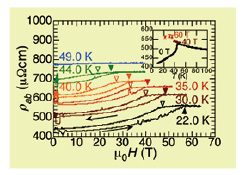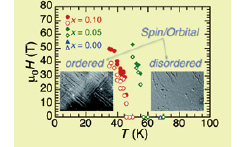Field-Induced Melting of Spin and Orbital Order in Sulfur-Doped Iron-Telluride
Tokunaga Group
Since 2008, iron-based superconductors have attracted considerable attention because of the occurrence of high temperature superconductivity in the vicinity of antiferromagnetic order similar to the cuprate superconductors [1]. The superconductivity in the cuprates emerges when antiferromagnetic states of the parent compounds are removed by chemical substitution, whereas that in the ironates can be induced also by application of pressure to the antiferromagnetic states. Therefore, it is naively interesting to study what happens if we can remove the antiferromagnetism in the parent compounds by application of magnetic fields. As far as we know, there is little challenge to suppress the antiferromagnetism by magnetic fields in this class of materials [2].

Fig. 1. Longitudinal magnetoresistance of the Fe1+yTe1-xSx crystal with nominal x = 0.10. The data were vertically offset for clarity. The positive magnetoresistance effects with prominent hystereses indicate the occurrence of first-order transitions from the antiferromagnetic state in zero field. The inset shows temperature dependence of the in-plane resistivity at μ0H = 0 T, 40 T, and 60 T. The resistivity in the high-field phase falls on the line extrapolated from that in the paramagnetic state in zero field indicating the melting of the spin order in the high-field phase.

Fig. 2. Field-temperature phase diagram of Fe1+yTe1-xSx for H || c-axis. The insets show the polarizing microscope images on the cleaved ab-plane surfaces of an x = 0.05 crystal. The stripe-like structure in the low temperature phase (left inset) represents the twin domains caused by the orbital order. Application of high magnetic field wiped out these stripe-like structures representing the field-induced melting of the orbital order [4].
We studied physical properties of Fe1+yTe1-xSx (x = 0, 0.05, and 0.10) in high magnetic fields. Since these materials have relatively low Néel temperatures (TN) among the ironates, we expect prominent effects of magnetic fields within our pulsed fields up to 65 T. The spin order in the iron-telluride is mysterious because the Fermi-surface nesting scenario, which can explain the stripe-type spin order found in most of the parent compounds of the ironate superconductors, cannot account for the bicollinear spin order in this compound. Since this spin order is accompanied by the ordering of the 3d orbitals in the iron ions, the correlation between these two ordering can play the key role to realize the unique antiferromagnetic state [3].
In zero fields, these crystals show steep decrease in resistance upon cooling below TN as shown in the inset of Fig. 1. Application of high magnetic fields to these antiferromagnetic states causes steep increases in resistance to the values extrapolated from those in the paramagnetic states, indicating the field-induced melting of the spin order (Fig. 1). The orbital order can be detected by direct observation of the sample surface because the violation of the four-fold symmetry within the ab-plane appears as the stripe-like twin structures in the polarizing microscope images as shown in the insets of Fig. 2. With using a high-speed camera, we captured the changes in polarizing microscope images in pulsed high magnetic fields across the phase boundary shown in Fig. 2. The obtained images visually demonstrate the collapse of the orbital order simultaneously with the melting of the spin order. Our results indicate the importance of the cross correlation between spin and lattice/orbital degrees of freedom in these compounds [4]. To study the ground states of the spin/orbital disordered states in this compounds, experiment in higher fields are in progress.
References
- [1] Y. Kamihara, T. Watanabe, M. Hirano, and H. Hosono, J. Am. Chem. Soc. 130, 3296 (2008).
- [2] M. Tokunaga, I. Katakura, N. Katayama, and K. Ohgushi, J. Low Temp. Phys. 159, 601 (2010).
- [3] A. M. Turner, F. Wang, and A. Vishwanath, Phys. Rev. B 80, 224504 (2009).
- [4] M. Tokunaga, T. Kihara, Y. Mizuguchi, and Y. Takano, J. Phys. Soc. Jpn. 81, 063703 (2012).
